Cycle tracks, the next great American infrastructure project? (At least right now, the answer is no.)
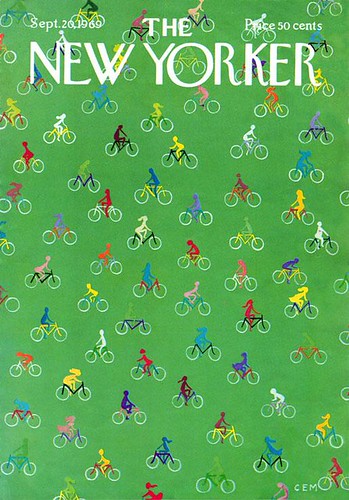 This New Yorker Magazine cover is from 1969.
This New Yorker Magazine cover is from 1969.A colleague sent me a link to this piece, "Why cycletrack networks should be the next great American transit project," in the Washington Post Innovations blog.
Unfortunately, the answer is no, although I don't disagree about the importance.
A country:
- unwilling to increase the gasoline excise tax especially at the federal level, but often at the state level too which is used to maintain the road network
- which has taken requirements to fund bicycle and transportation infrastructure as part of "road projects" out of federal transportation legislation
- which is letting its mobility infrastructure languish at all levels
- where funding and building and operating transit is a slog
- which is failing to build a national high speed rail network
HOWEVER, it is cities and inner suburbs where bicycling has great opportunity to capture many trips--51% of all trips are three miles or less, 28% of trips are 1 mile or less, and 13% of trips are 3-5 miles, so that 64% of trips are 5 miles or less--and that's where, if you want to have significant impact, biking infrastructure expansion has to be focused.
For guidance, see these past blog entries:
-- What should a US national bike strategy plan look like? (2014)
-- Are developers missing the point on eliminating parking minimums?: it's to promote sustainable transportation modes (2012)
-- Best practice bicycle planning for suburban settings using the action planning method (2010)
-- Ideas for making bicycling irresistible in Washington DC (2008)
-- (Not exactly) Bike sharing as "Critical Mass," bikelash and changing mobility paradigms: some lessons from Salt Lake City (2013)
-- Best (or at least better) practices bike parking and bicycle facilities implementation (2011)
-- How to make bicycling a significant transport mode over long distances: dedicated infrastructure (2012)
Unfortunately, our transportation policies at the federal, state, and regional scales aren't shaped to distinguish in substantive ways sustainable transportation policy--walking, biking, transit--according to the opportunities presented within urban, inner suburban, outer suburban, and exurban built environments and the mobility networks therein.
That being said, many cities big--Boston, New York, Chicago, Minneapolis, Philadelphia, Portland, Seattle, Washington, etc. and small(er)--Cambridge, MA, Pasadena, Macon, etc--are doing great things in expanding bike and pedestrian infrastructure.
In the DC area, besides the efforts in DC, suburban jurisdictions are doing important work:
- Montgomery County is doing a new bike master plan
- Prince George's County is planning the Central Corridor Trail, which could become an example of national significance connecting 4 Metro Stations, and dozens of neighborhoods, schools, parks, other civic assets, commercial districts and other destinations along the Blue Line Metrorail route in the county
- Arlington County, despite some recent hiccups, is a national leader in inner suburban sustainable transportation planning and infrastructure development efforts, including having created the first bike share master plan for a county, leading the DC-area's bike share implementation (DC signed onto the contract that Arlington negotiated), expanding bike parking, etc.
I've seen photos of the new Potomac Avenue Trail in Alexandria, Virginia--haven't been there yet--and I was impressed.
Same with the S-Line trail alongside the "new" streetcar in Salt Lake City (pictured at right, Salt Lake Tribune photo).
And many other jurisdictions do bike and pedestrian planning at the county-wide scale, and develop metropolitan bikeway networks, incorporate bike access on transit, are expanding bike parking and complementary facilities, etc.
Still, in honor of the Post article, I am reprinting this piece from July 2010. Seeing, and using a little bit, Montreal's cycletrack network, then as now, the largest cycletrack network in North America, introduced me to cycletracks and made me a fervent supporter.
Similarly, using the Bixi bike sharing program there, I came to understand the value of bike sharing.
Plus, wrt Montreal, at the time I wasn't familiar with the extensive research and writing about biking and sustainable transportation by academics at McGill University which is another advantage Montreal has over most North American cities, other than Portland and PSU, and to some extent UC Davis and some of the other UC campuses-cities.
And yes, in the five years that has elapsed since this piece, many US cities, including New York, Washington, Chicago, Los Angeles, etc. have been developing and expanding cycle track networks throughout their communities, even at the expense of angering business and residential stakeholders.
Is Montreal the number one city for bicycling in North America?
Am vacationing in Montreal. We`re staying in a house in `The Village` area, which is about one block away from the Beaudry Metro Station, and five blocks from the Berri-UQAM Metro Station, which is the equivalent of `DC`s `Metro Center`where three of the four lines cross--so getting around by transit is easy, especially combined with bus, of course things are close and you can get to many places on foot.
I know that Portland, Oregon and Davis, California duke it out over which is the best city for bicycling in the United States. And New York City, with the variety of initiatives that have come forth there over the past two years under Transportation Commissioner Janette Sadik-Khan, is a rising contender.
Now I haven`t been to Portland for a few years, so I imagine that it has improved for biking in the intervening years, and it was already a great example of bike commuting and accommodating bicyclists on bridges. Certainly, the Intiative for Bicycle and Pedestrian Innovation at Portland State University is pumping out great information, such as the manual
FUNDAMENTALS OF BICYCLE BOULEVARD PLANNING & DESIGN by Lindsay Walker et al.
But, seeing how Montreal has an extensive network of piste cyclables or bike paths, which include cycle tracks, or dedicated lanes for bicyclists, located within the road right-of-way throughout the city--and they are used--and function like the cycle superhighways that Boris Johnson claims to be bringing to London and what Tom Vanderbilt writes about in Salon, Bicycle Highways: Should cities build specialized roadways for cyclists? -- although note that this is something that Professor John Pucher of Rutgers University has been saying-writing-researching-presenting-speaking about for many years before Tom Vanderbilt -- clearly the answer is yes.
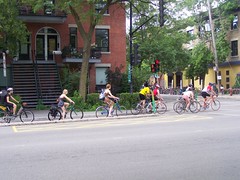
Piste Cyclable on Rue Rachel, Montreal (across from Park Fairmount).
Although some of the writing is a bit misleading because cycle tracks, while dedicated, don`t have to be separated from the overall roadway, they are placed within it, but in a protected fashion.
The interesting thing about the cycletracks in Montreal is that they are not placed on each side of the roadway, in the same direction as the traffic. Instead, they are two way lanes placed on one side of the street.
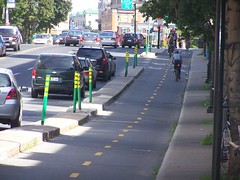
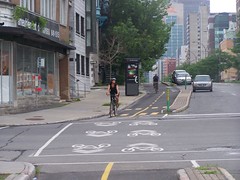
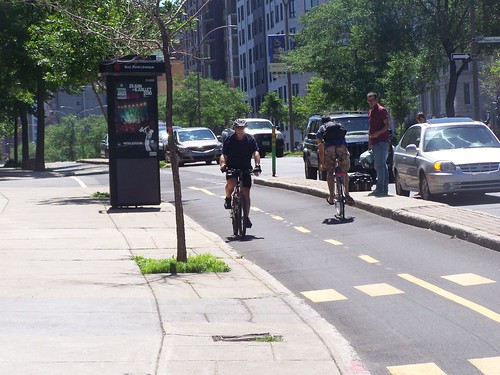
But cycle tracks-cycle superhighways aren`t the only reason that Montreal should be considered the number one place for cycling in North America. Besides the fact that people actually bicycle in the lanes (e.g., I`ve barely seen people use the contraflow cycle track on 15th Street, while the cycle tracks in Montreal are teeming with cyclists--some duded up in cycling gear and clothing, but most not--maybe the cyclists aren`t as pretty as those featured in Copenhagen Chic or Riding Pretty blogs, but they are transportational cyclists nonetheless.
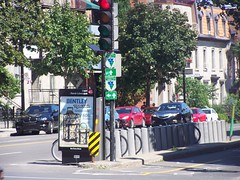
The idea for the Route Verte was initiated by VeloQuebec, the provincial bicycling advocacy group, and after a few years the idea was taken up by the provinicial transportation agency.
The Provincial Transportation agency has a publication, Making cycling a mode of transportation in its own right, which discusses the provincial bicycle policy and programs to aid alternative modes of transportation to the car.
[Note this publication is no longer available on the web. I will try to track it down. A newer publication, Bicycling in Quebec 2010, has superseded it.)
According to the publication, Quebec is the place in North America where bicycling is most widespread, as proportionally there are 2.5 times more cyclists in Quebec than in Canada as a whole, and 2 times more than in the U.S.
The link to the publication is the longer piece. I came across a four page brochure in an information rack in a local museum (in both French and English).
But then there is Bixi, the bicycle sharing program in Montreal.
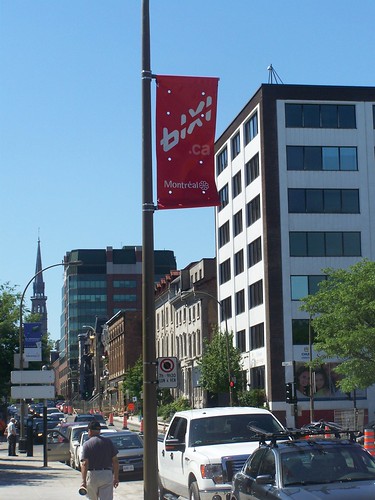
A street banner promoting the Bixi bicycle sharing program in Montreal
Now us Washingtonians get bent out of shape when Bixi claims that they are the first public bikesharing program in North America, when the SmartBike program in DC was first.
BUT, being here, I guess I see their point.
The DC program is a pilot, with a handful of stations (something like 10) and maybe 150 bikes--which are barely use as each bike experiences fewer than 2 trips per day, while the Montreal system is widespread with 400 stations and 5,000 bicycles, and they are set up to be used not just by subscribers--the DC system is restricted to subscribers, but by anyone with a credit card, someone like me, who is visiting...
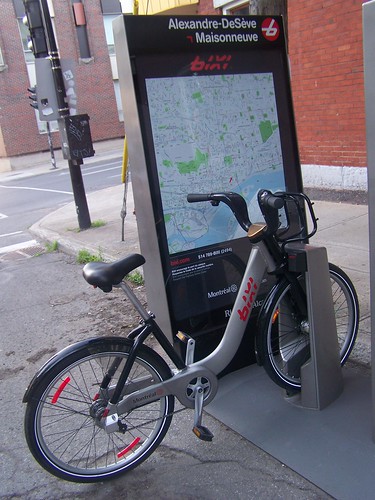
Bixi station map.
The stations are placed no more than 300 meters (1,000 feet) apart. Because Montreal is actually made up of separate arondissements, kind of like towns, parts of the city are not covered by Bixi because of lack of density or because the arondissement, such as Westmount, see `Westmount in 'no rush' for Bixi` from the Montreal Gazette, does not participate.
If you know how to bike, how to use a credit card, how to `consume` a city, and how to read a map (although it took me a few minutes to figure out how to unlock a bike from the station) you can use Bixi whether or not you are a `member`.
It really allows you to explore far more of a city--block by block--than you can by regular transit. (Now there are reasons why such a system works better in Montreal than in a place like DC but I`ll write about that when I get back.)
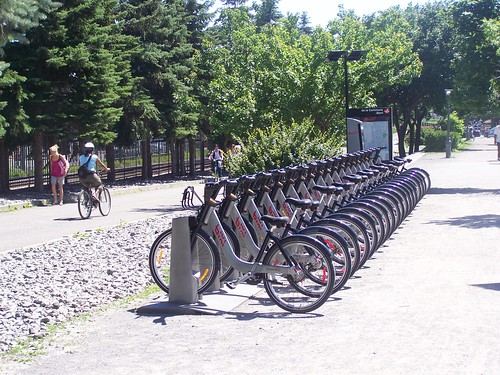
Bixi station approaching the Old Port of Montreal

Above and below, Bixi cyclists in the Old Port of Montreal.
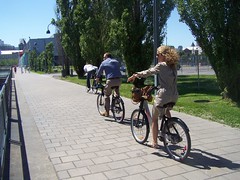

Woman on a Bixi in Victoria Square, Montreal.
As an indicator of a high rate of bicycling--biking is part of how people get around day-to-day, what some people call `culture`but what I think of as bicycling as a part of every day mobility behavior or ``way of life``--that there are public bike racks in neighborhoods, because of a need to secure bikes and people living in smaller places or on upper floors, when bringing a bike in can be a problem.
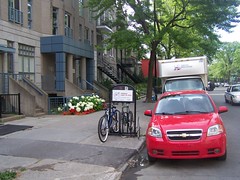
Finally, the thing that puts Montreal to the number one position may be the fact that Vélo Québec, the city and provincial bicycle advocacy organization, has the makings of the `bike center` that WashCycle got our hopes up on in an April fools blog entry. The VeloQuebec office on Rue Rachel, across from Fairmount Park is also a cafe, cycle bookstore, and cycle travel office.
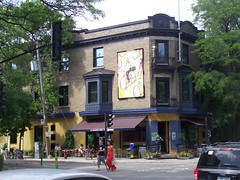

Vélo Québec also publishes a full-blown magazine, VeloMag, in French of course. The latest issue comes bagged with maps of various cities, such as Quebec City, which paid to include their bike maps as advertisements in the issue.
And Vélo Québec also created a fabulous (but expensive) manual for bike and pedestrian planning, (in French and English editions) which covers just about everything, even things I hadn`t considered when producing the forthcoming Western Baltimore County Pedestrian and Bicycle Access Plan.
Maybe all of that doesn`t make Montreal the number one city for bicycling in North America--I did notice that they only provide certain services (Bixi and bike lanes) from April to November, which might mean that they don`t do snow clearance of bike lanes and paths in the winter--but it has to come pretty close.
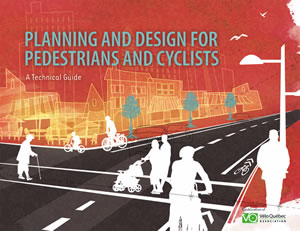
Speaking of John Pucher, here is one of his articles that I have to read...
"Why Canadians Cycle More than Americans: A Comparative Analysis of Bicycling Trends and Policies," Transport Policy, May 2006, Vol. 13, pp. 265-279 (with Ralph Buehler). Click here for PDF.
Labels: bicycle and pedestrian planning, car culture and automobility, transportation infrastructure, transportation planning

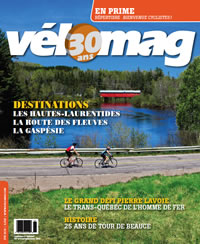



3 Comments:
all of the Anglo countries- even Canada- are far behind even small towns in western Germany or Holland as far as cycling infrastructre goes. John Pucher knows this and that is why he often studies these countries and features them in his papers.
quebec, especially Montreal, is not behind. It's the exception that proves the rule of what should be focused on and addressed.
But Canada is marginally ahead of the US on biking because it is less sprawled.
Thank you for providing such a valuable information and thanks for sharing this matter. to get Online pharmacy from online medicine store.
Post a Comment
<< Home